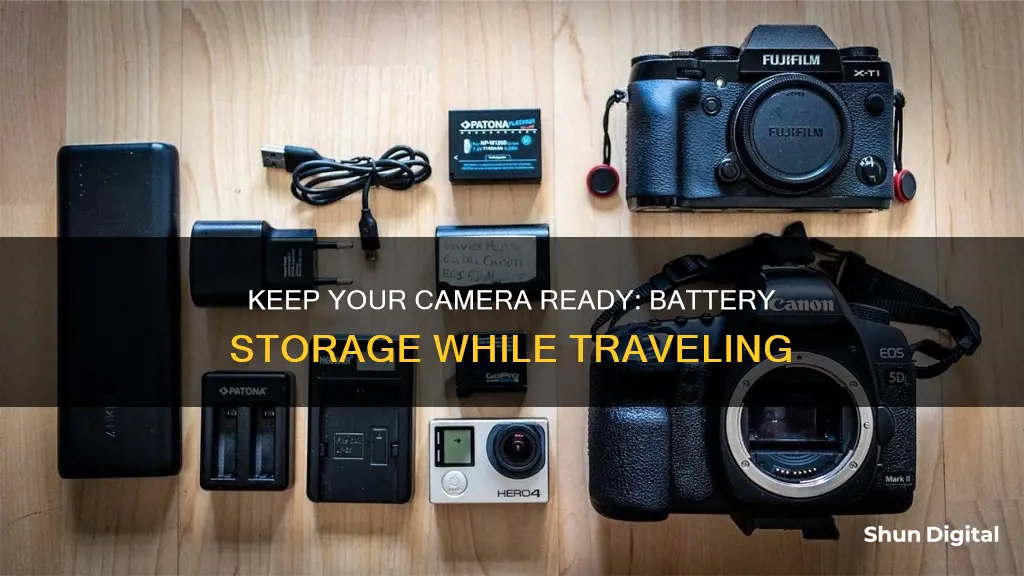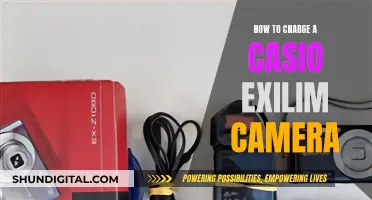
Travelling with a camera can be stressful, especially when it comes to batteries. It's important to know the rules and regulations to ensure a smooth journey. The last thing you want is to be stopped at airport security or, worse, have your equipment damaged or confiscated. So, what's the deal with leaving a battery in your camera while travelling?
First, it's crucial to understand the type of battery your camera uses. Most camera batteries are lithium-ion, which have specific travel restrictions due to their combustion potential. These rules vary by country and airline, so it's essential to check before you travel. In general, lithium-ion batteries below 100Wh are typically allowed in carry-on baggage. However, it's recommended to keep them in your carry-on to prevent damage and ensure easy access.
Additionally, spare lithium-ion batteries should be treated with extra care. These must be carried in your carry-on baggage and properly protected to prevent short circuits. Tape can be used to cover battery terminals, and original packaging or plastic bags can provide insulation.
When flying, it's also worth considering a hard case, like the Pelican 1510, to protect your camera and batteries. While camera gear is usually safe in the hold, a hard case offers extra security and peace of mind.
In summary, leaving a battery in your camera while travelling is generally safe, but it's essential to be aware of the specific rules and regulations of your airline and destination country. Properly preparing and protecting your batteries will ensure a smooth journey and give you peace of mind.
| Characteristics | Values |
|---|---|
| Should you leave a battery in your camera while travelling? | It is generally safe to leave a battery in your camera while travelling. |
| Battery type | Lithium-ion batteries are commonly used in cameras. |
| Battery storage | Store lithium-ion batteries in a cool, dry place. |
| Battery transportation | Transport lithium-ion batteries in carry-on luggage only. |
| Battery quantity | There is no limit to the number of lithium-ion batteries you can bring on a plane, as long as they are below 100 Wh. |
| Battery protection | Protect battery terminals by using the manufacturer's packaging or covering the terminals with tape. |
What You'll Learn

Flying with lithium-ion batteries
Lithium-ion batteries are a common power source for many of our everyday devices, such as smartphones, tablets, cameras, and laptops. When travelling with these devices, it's important to follow the guidelines to ensure safety and comply with aviation regulations. Here's a comprehensive guide on how to travel with lithium-ion batteries:
Installed Lithium-Ion Batteries
If your camera, laptop, or other devices have installed lithium-ion batteries, it's generally considered safe to bring them on board. The US Federal Aviation Administration (FAA) recommends keeping these devices in your carry-on baggage. If they must be placed in checked baggage, follow these precautions:
- Turn the devices completely off.
- Protect them from accidental activation.
- Pack them securely to prevent damage.
Spare Lithium-Ion Batteries
Spare lithium-ion batteries, including power banks and cell phone charging cases, must be treated with extra care. These batteries should only be carried in your carry-on baggage. Keeping them with you is crucial because loose lithium batteries in the cargo hold can pose a fire hazard without anyone available to intervene.
Battery Specifications and Limits
To ensure safety, it's important to be mindful of the specifications and limits for lithium-ion batteries:
- Lithium-ion batteries are typically limited to a rating of 100 watt-hours (Wh) or less per battery.
- With airline approval, you may carry up to two larger spare lithium-ion batteries ranging from 101-160 Wh.
- To prevent short circuits, protect the battery terminals by using the manufacturer's packaging or covering them with tape.
- Place the batteries in separate bags to provide additional protection.
- Do not carry damaged, defective, or recalled lithium batteries if they pose a safety concern, such as overheating or catching fire.
Packing Tips and Recommendations
- Check the condition of your batteries before packing. Ensure there is no swelling or damage.
- Use battery cases or plastic wraps to secure the batteries and prevent short circuits.
- Keep batteries away from metal objects like keys or coins, as they can cause sparks.
- Tape up the metal contacts on the batteries to prevent short-circuiting. Use camera tape to avoid leaving sticky residue.
- Be mindful of weight limits and ensure you don't exceed them.
- Consider investing in a hard case, such as the Pelican 1510, that fits within carry-on size restrictions and allows you to store your camera and batteries safely.
Charging Your GE Camera: A Quick Guide
You may want to see also

Battery storage and safety
When travelling with camera equipment, it is important to consider the safety of the batteries you are carrying. Most camera batteries are lithium-ion batteries, which have been known to pose a fire risk. As such, there are strict rules in place regarding how to store and transport them.
Packing Batteries
Firstly, it is important to note that you should always carry your batteries in your carry-on luggage. This is because, in the event of a fire, cabin crew can address the issue, whereas a fire in the cargo hold presents a far greater risk. In fact, some sources suggest that loose lithium batteries in the cargo hold can pose a fire hazard without anyone available to intervene and stop the fire.
When packing your batteries, it is important to take steps to prevent short circuits. This can be done by using the manufacturer's packaging or covering the terminals with tape. It is also recommended to place each battery in a separate bag for further protection.
Battery Quantity and Power
There are limits to the number and power of lithium batteries you can carry. Each person is limited to a maximum of 20 spare batteries. For lithium-ion batteries, the limit is 100-watt hours per battery. However, with airline approval, you can carry up to two spare larger lithium-ion batteries (101-160 Wh). For lithium-metal batteries, the limit is 2 grams of lithium per battery.
Installed vs. Spare Batteries
Installed lithium-ion batteries tucked away in your camera are generally considered safe. However, the US Federal Aviation Administration (FAA) recommends that devices containing these batteries, including cameras, be kept in carry-on baggage. If they must go in checked luggage, turn them off, prevent accidental activation, and pack them to avoid damage.
Spare lithium-ion batteries, on the other hand, should always be carried in your carry-on luggage.
Battery Condition
It is important to only travel with batteries that are in good condition. Do not travel with damaged, defective, or recalled batteries, as these can pose a safety risk. Additionally, make sure to check the condition of your batteries before packing them, ensuring that they show no signs of swelling or damage.
Charging Your Subnautica Drone: A Step-by-Step Guide
You may want to see also

TSA and airline rules
When travelling with camera equipment, it's important to be aware of the relevant TSA and airline rules. Here's what you need to know:
Lithium-ion Batteries
Lithium-ion batteries are commonly found in cameras, smartphones, laptops, and tablets. These batteries have specific rules due to their potential for rapid combustion. While installed lithium-ion batteries tucked away in your devices are generally safe, the US Federal Aviation Administration (FAA) recommends keeping them in your carry-on baggage. If you must pack them in checked luggage, be sure to turn them off, prevent accidental activation, and pack them securely to avoid damage.
Spare Lithium-ion Batteries
Spare lithium-ion batteries should always be carried in your carry-on baggage. This is because loose lithium batteries in checked bags pose a greater fire risk if damaged, and having them in the cabin allows crew to respond quickly in an emergency. Additionally, the FAA sets limits on lithium-ion batteries: 100-watt hours per battery or, with airline approval, up to two spare batteries ranging from 101-160 watt hours.
Protecting Battery Terminals
To prevent short circuits, it is crucial to protect the battery terminals. This can be done by using the manufacturer's packaging or covering the terminals with tape. Keeping batteries in separate bags provides additional protection.
Alkaline Batteries
Standard dry cell alkaline batteries such as AA, AAA, C, and D are typically allowed in both carry-on and checked luggage without quantity restrictions. However, it is important to safeguard them from damage, sparks, and overheating, as per TSA guidelines.
International Laws
International laws for air travel prohibit carrying lithium batteries in the hold of an airplane. All lithium-ion and lithium metal batteries should be carried in your hand luggage. Additionally, it is recommended to tape up the metal contacts on the batteries to prevent short-circuiting.
Damaged Batteries
Never travel with damaged batteries. If a battery becomes damaged during your trip, dispose of it properly. It is dangerous to carry damaged batteries on an aircraft.
Hive Camera: Battery Operated or Not?
You may want to see also

Packing camera gear
When packing camera gear for a flight, it's important to keep the batteries with you in your carry-on luggage. This is because lithium-ion batteries, which are commonly found in cameras, have a recognised risk of rapid combustion. Keeping these batteries in the cabin means that, in the unlikely event of a fire, it can be addressed quickly.
- Choose a carry-on bag that complies with airline size limitations. A hard case, such as the Pelican 1510, can provide extra protection for your equipment.
- Keep your most valuable items, such as cameras and necessary batteries, in your carry-on bag. This ensures they are within arm's reach and reduces the risk of damage.
- Check the weight limits for carry-on and checked baggage. Camera equipment can be heavy, and you may need to pay for excess baggage. It may be helpful to distribute some equipment across your pockets to reduce the weight of your carry-on.
- If you have professional camera gear, check the specific guidance provided by aviation authorities such as the FAA or EASA. These regulations are in place to ensure flight safety.
- Tape up the metal contacts on your batteries to prevent short-circuiting. You can use camera tape, which won't leave any sticky residue. Alternatively, place each battery in its own protective case or plastic bag.
- Keep spare batteries in their original retail packaging, if possible. This helps prevent unintentional activation or short-circuiting.
- Be prepared for additional security checks when travelling with camera gear. It is common to be "randomly selected" for a pat-down or to have your carry-on bags pulled aside for further inspection.
- If you are travelling with a drone, ensure the battery is in your carry-on luggage.
- Consider investing in a media bag if you are travelling with a large amount of equipment. Some airlines offer discounted rates and waived fees for media accounts.
- Always check the latest regulations provided by the airline you are travelling with, as rules may vary.
Replacing Batteries in Your WGI Innovation Nano Camera
You may want to see also

Camera insurance
When travelling with a camera, it is important to consider the safety of your equipment. One way to do this is to insure your camera and any accompanying gear. Camera insurance can protect your equipment from accidental damage, theft, and fire, depending on your policy. This can save you from pricey repairs or replacements, which could cost thousands of dollars.
There are a variety of insurance options available for cameras and camera equipment, with some policies offering coverage of up to $75,000. The cost of insurance will depend on the value of your equipment and the level of coverage you require. For example, insurance for $199 worth of camera equipment can cost as little as $2.92 per month, while insurance for $14,000 worth of equipment can cost around $300 per year.
It is worth noting that some standard homeowners' and renters' insurance policies may provide limited coverage for camera equipment, but this may not include protection from accidental damage. Additionally, the deductible on these policies may be higher than a specialised camera insurance policy. You can also add a rider to your existing insurance policy to cover your camera equipment, which may offer more protection than the primary policy.
When travelling, it is important to consider the safety of your camera batteries. Lithium-ion batteries, which are commonly found in cameras, are considered safe if they are installed inside the camera and stored in carry-on baggage. However, if you are carrying spare batteries, these should be stored separately in your carry-on luggage to prevent the risk of fire. To prevent short circuits, it is recommended to cover the battery terminals with tape and place the batteries in separate bags.
By insuring your camera equipment and following the appropriate safety guidelines for battery storage, you can have peace of mind that your equipment is protected while travelling.
Activeon Action Camera: Swappable Batteries?
You may want to see also
Frequently asked questions
Yes, it is safe to leave a battery in your camera while travelling. However, it is important to ensure that the battery is protected from damage and that it does not come into contact with metal objects, as this could lead to a short circuit.
Standard dry cell alkaline batteries (AA, AAA, C, and D) can be freely taken on board a plane without any restrictions. Lithium-ion batteries, on the other hand, have specific regulations that vary depending on the country and airline. It is generally recommended to carry these batteries in your hand luggage and to check the rules of the specific airline before travelling.
When packing batteries, it is important to prevent short circuits by using battery cases, plastic wraps, or tape to cover the terminals. Keep batteries separated from other metal objects and place them in a carry-on bag, which will allow you to monitor them during the flight.
Yes, the weight and quantity limits for batteries when flying vary depending on the type of battery and the regulations of the specific country and airline. It is important to check these regulations before travelling to ensure compliance.
In addition to properly packing and storing your batteries, there are a few other considerations when travelling with camera equipment. It is recommended to use a hard case, such as a Pelican case, to protect your equipment from impact damage. It is also a good idea to back up your photos and videos by keeping one copy in your carry-on bag and another in your checked luggage. Finally, be mindful of weight limits and distribute your equipment accordingly to avoid excess baggage fees.







